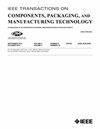Bare-Die Embedding Technique for Highly Integrated Power Electronics for Small Mobility
IF 2.3
3区 工程技术
Q2 ENGINEERING, ELECTRICAL & ELECTRONIC
IEEE Transactions on Components, Packaging and Manufacturing Technology
Pub Date : 2025-01-16
DOI:10.1109/TCPMT.2025.3530398
引用次数: 0
Abstract
Small mobility vehicles such as electric scooters are becoming an integral part of the transition toward electrified transportation. However, the limited driving range and the lack of onboard charging capability are the major challenges for widespread adaptation, which arises due to the limited space for power electronics units and batteries on the chassis of small mobility vehicles. This research introduces a new bare-die embedding printed circuit board (PCB) packaging technology, ensuring a very compact, high power density, and integrated design for the power electronics unit. The design incorporates the bare die of the switching devices into the PCB layers and uses multilayers for routing and cooling purposes. A silicon (Si) MOSFET bare die is embedded into the FR4 layers using the stomach cell approach, electrically connected, and cooled through laser-drilled micro vias and copper fills. The electrothermal design reduces the parasitic loop inductance by 74%, increases the power density by 113%, and enhances the driving range of the small mobility vehicle by 16.6% compared with the traditional TO-247 packaging approach. Moreover, a new thermal model is also presented and validated for the bare-die embedded board. A high power density power electronics unit integrating the motor drive and the onboard charger was developed using the proposed bare-die embedding technology, and a benchmark comparison was made to evaluate the effectiveness of the proposed bare-die embedding technique.电动滑板车等小型代步车正在成为向电气化交通过渡的一个组成部分。然而,由于小型代步车底盘上的电力电子装置和电池空间有限,其行驶里程有限且缺乏车载充电功能,这是其广泛应用所面临的主要挑战。这项研究引入了一种新的裸芯片嵌入印刷电路板(PCB)封装技术,确保了电力电子单元的非常紧凑、高功率密度和集成设计。该设计将开关器件的裸芯片嵌入印刷电路板层,并使用多层板进行布线和冷却。硅(Si)MOSFET 裸芯片采用胃单元方法嵌入 FR4 层,通过激光钻孔微孔和铜填充进行电气连接和冷却。与传统的 TO-247 封装方法相比,这种电热设计将寄生环路电感降低了 74%,将功率密度提高了 113%,并将小型移动车辆的行驶里程提高了 16.6%。此外,还提出了一种新的热模型,并对裸片嵌入式电路板进行了验证。利用所提出的裸片嵌入技术开发了一个集成了电机驱动和车载充电器的高功率密度电力电子装置,并进行了基准比较,以评估所提出的裸片嵌入技术的有效性。
本文章由计算机程序翻译,如有差异,请以英文原文为准。
求助全文
约1分钟内获得全文
求助全文
来源期刊

IEEE Transactions on Components, Packaging and Manufacturing Technology
ENGINEERING, MANUFACTURING-ENGINEERING, ELECTRICAL & ELECTRONIC
CiteScore
4.70
自引率
13.60%
发文量
203
审稿时长
3 months
期刊介绍:
IEEE Transactions on Components, Packaging, and Manufacturing Technology publishes research and application articles on modeling, design, building blocks, technical infrastructure, and analysis underpinning electronic, photonic and MEMS packaging, in addition to new developments in passive components, electrical contacts and connectors, thermal management, and device reliability; as well as the manufacture of electronics parts and assemblies, with broad coverage of design, factory modeling, assembly methods, quality, product robustness, and design-for-environment.
 求助内容:
求助内容: 应助结果提醒方式:
应助结果提醒方式:


